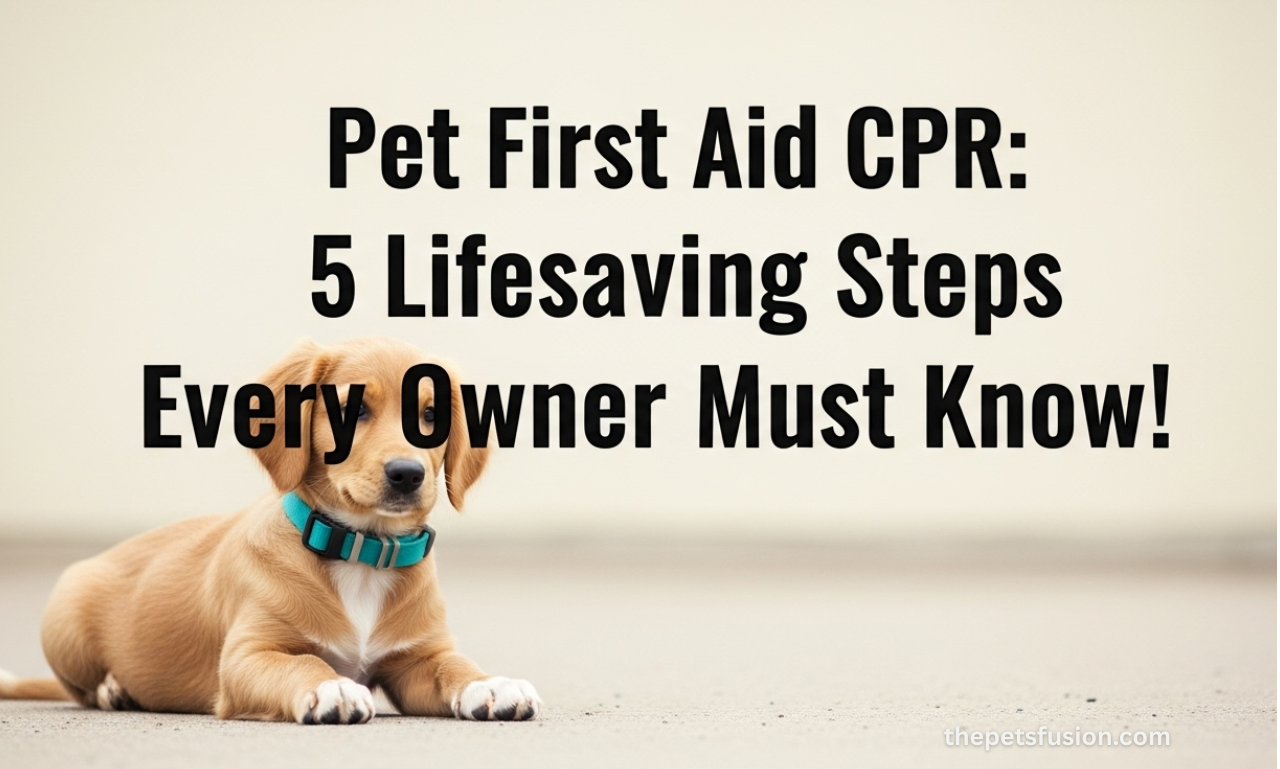You come home, calling your dog like always—but something’s wrong. They’re lying there, motionless, not breathing—your heart races. Panic sets in. What now? In a pet emergency, every moment matters, and knowing pet first aid CPR can save your pet’s life. Accidents can happen suddenly, like choking or heart problems. That’s why learning these essential skills is a must, not a choice. In this guide, we will explain the five critical steps of pet first aid CPR. We’ll help you get certified and provide you with the tools you need to stay calm, act quickly, and possibly save your pet’s life.
Why Pet First Aid CPR Matters
When you get a pet, you’re not just getting a friend—you’re also agreeing to take care of them and keep them safe. However, many pet owners aren’t prepared for emergencies. Your dog or cat can experience an emergency at any moment, such as choking, heatstroke, or heart problems. Pet first aid CPR gives you the power to act quickly and effectively before professional help arrives.
A Pet Emergency Can Happen Anytime
Unlike humans, pets can’t tell you when something’s wrong. Emergencies like:
- Sudden collapse
- Difficulty breathing
- Seizures or trauma
…can occur without warning. In those precious first minutes, your response is critical.
Veterinarians often say that if more pet owners were trained in canine first aid CPR, many pet fatalities could be prevented. Imagine how helpless you’d feel watching your pet suffer while waiting for help. Training provides you with the confidence and skills to step in until a veterinarian takes over.
Even better? Learning pet first aid and CPR doesn’t just help your pets—it can also help someone else in the park, at daycare, or anywhere emergencies may occur.
Understanding Pet Vital Signs: Know What’s Normal
To know when something is wrong with your pet, you first need to understand what is normal for them. Just like with people, the first thing to do in pet first aid CPR is to check vital signs. These signs can help you know if your pet is having problems.
The Key Vital Signs to Watch
Here’s what you should check regularly (and especially during an emergency):
Heart Rate
- Dogs: 60–140 beats per minute
- Cats: 140–220 beats per minute
- To check: Place your fingers on the inside of the hind leg or over the heart (behind the left elbow).
Respiratory Rate
- Dogs: 10–35 breaths per minute
- Cats: 20–30 breaths per minute
- Look at the chest moving up and down, or check for air coming from the nose.
Temperature
- Normal for both: 100.5–102.5°F (38–39.2°C)
- Use a digital pet thermometer rectally for accuracy.
Capillary Refill Time (CRT)
- Press on the gums and release—color should return in under 2 seconds.
Mucous Membrane Color
- Gums should be pink, not pale, blue, or bright red—each abnormal shade signals different emergencies.
Recognizing these signs is essential before starting dog first aid training. Knowing when your pet is in danger—versus just tired or overheated—can save precious time and effort during a crisis.
The 5 Lifesaving Pet First Aid CPR Steps
Knowing how to react in those critical first moments when your pet collapses or stops breathing can make the difference between life and death. Whether you’ve completed a pet first aid & CPR class or you’re learning for the first time, these five steps are the foundation of emergency care for pets.
Step 1: Check Responsiveness and Breathing
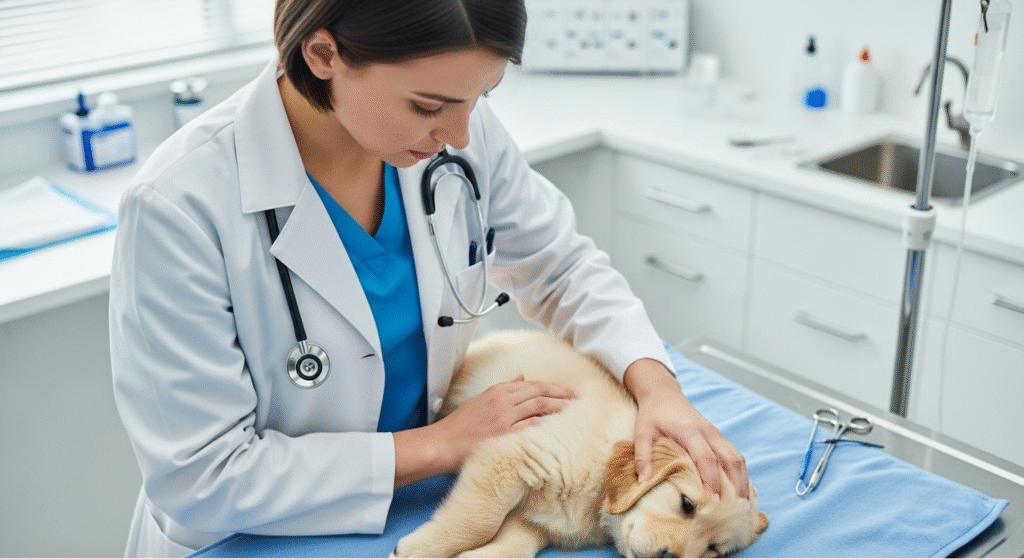
The first thing you must do is determine whether your pet is conscious and breathing. Gently tap their body or call their name. If there’s no response, carefully observe their chest to see if it’s rising and falling. You can also feel for airflow by placing your hand or cheek near the nostrils.
If your pet is unresponsive and not breathing normally (or not breathing at all), it’s time to act quickly.
Step 2: Clear the Airway
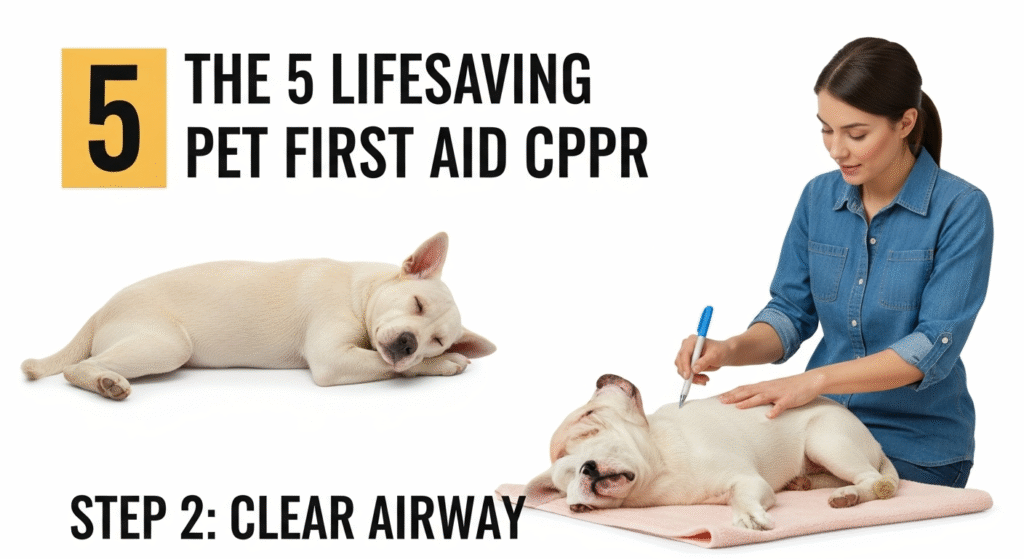
Sometimes pets can faint because something is stuck in their throat or airway. Open your mouth and gently look for anything that might be blocking it, such as toys, food, or vomit. Be careful—don’t push anything in further. If you can see it and it’s easily accessible, gently remove it with your fingers or a soft tool. Never attempt to clear the airway without first examining it. If you’re unsure, proceed directly to administering rescue breaths.
Step 3: Begin Rescue Breathing
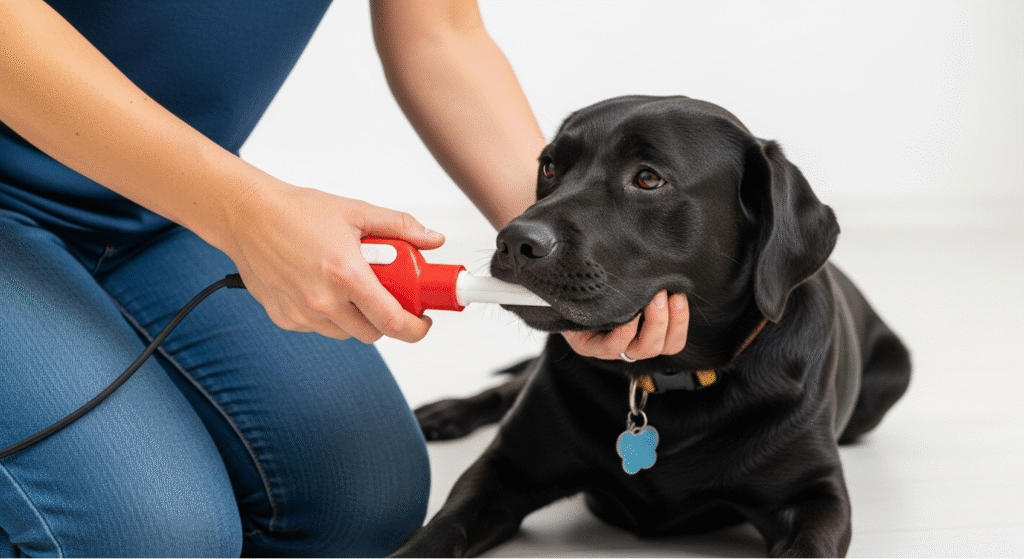
Once the airway is clear, but the pet still isn’t breathing, begin rescue breaths. Close the pet’s mouth and extend the neck to ensure an open airway. For dogs and cats, gently blow into the nose—not the mouth—until the chest visibly rises. Deliver one breath every 4 to 6 seconds.
This is a critical part of canine first aid CPR, especially if your pet has a heartbeat but isn’t breathing.
Step 4: Start Chest Compressions

If there’s no pulse (you can check at the femoral artery inside the thigh), immediately begin CPR compressions. Lay your pet on its right side on a firm surface. Position your hands just above the heart:
- For small pets: Use your fingers and compress 100–120 times per minute
- For medium to large pets: Use both hands, compress 1/3 of the width of the chest
Alternate 30 compressions with two rescue breaths. Continue this cycle for two minutes before checking again for a pulse or breath.
Step 5: Continue Until Help Arrives
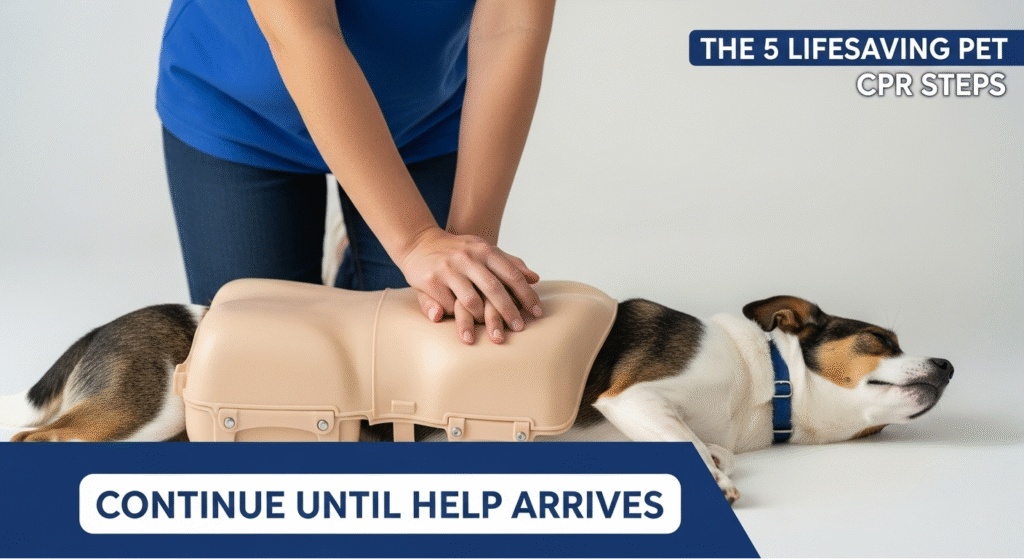
CPR is physically demanding, but stopping too early can be fatal. Continue cycles of compressions and breaths until your pet revives, someone else takes over, or you arrive at an emergency veterinary clinic. If you’re trained, use an animal-specific CPR chart as a quick guide.
This is why dog first aid training is so necessary—when you’re calm and confident, you give your pet the best chance of survival.
Common Pet Emergencies and What to Do
Emergencies can happen in the blink of an eye—and pets, just like humans, are vulnerable to sudden health crises. Being able to recognize the early signs and understanding how to answer can make all the difference. While pet first aid CPR is critical in life-threatening scenarios, many emergencies require quick, thoughtful first aid before reaching a vet.
Choking
If your dog or cat is choking at their mouth, making gagging noises, or struggling to breathe, they may be choking. Open their mouth carefully and look for an object. Only attempt to remove it if it’s visible and easy to grasp. If the object is lodged and you can’t remove it, gently apply abdominal thrusts (Heimlich maneuver for pets) or immediately head to the emergency vet.
Bleeding or Deep Cuts
Severe bleeding from trauma or accidents should be addressed immediately. Press down firmly with a clean towel or cloth. If bleeding is on a limb, you may use a temporary tourniquet above the wound, but only until you can get veterinary help.
Avoid applying ointments or powders unless instructed to do so by a veterinarian. Keep the area clean, and limit your pet’s movement.
Heatstroke
Heatstroke is a common condition, especially in dogs during the warmer months. Heavy panting, drooling, lethargy, and even seizures are common signs. Move your pet to a shaded or air-conditioned area immediately.
Use cool (not cold) water to lower their body temperature—wet towels, fans, or a spray bottle are effective options. Avoid ice baths, as they can cause hypothermia and potentially lead to shock. Take your pet to a vet as soon as they are stable.
Poisoning or Toxin Exposure
Ingestion of chocolate, xylitol, grapes, certain plants, or household chemicals can be fatal to pets. If you suspect poisoning, don’t induce vomiting unless specifically instructed by a vet or poison control. Call your vet or an emergency poison hotline immediately.
Keep a pet first aid and CPR quick reference card nearby with emergency numbers, symptoms to watch for, and poison control contacts.
Seizures
If your pet is experiencing a seizure, do not attempt to restrain them or place anything in their mouth. Clear the area of any complex objects they might bump into and keep yourself calm. Most seizures last under a minute. Once it passes, keep your pet warm and comforted. Contact your veterinarian to report the incident.
Seizures are often signs of underlying issues, so even a single event should be checked professionally.
Fractures or Sprains
If your pet is limping, refusing to move a limb, or crying in pain, immobilize the injured area with a towel or splint if possible. Avoid manipulating the limb too much. Transport your pet gently and head straight to the vet.
These scenarios highlight the importance of dog first aid training, so you’re not caught off guard.
Getting Certified in Pet CPR & First Aid
Learning about emergencies is one thing, but knowing how to act in real-time is a whole different level of preparedness. That’s where certification makes a real impact. Getting officially trained in pet first aid CPR can transform you from a concerned pet parent into a confident lifesaver.
Many pet owners believe that first aid training is only for professionals, such as veterinarians or dog trainers. However, in reality, pet CPR and first aid certifications are designed for everyday pet owners like you. These helpful courses teach you how to quickly identify emergencies, take the right actions immediately, and give your pet the best chance to stay safe until help arrives.
So, how to get certified in pet CPR and first aid? Some reliable organizations offer training recognized nationwide.
PetTech
One of the most well-known programs, PetTech offers in-person and online courses across the U.S. Their instructors cover CPR for dogs and cats, bandaging techniques, choking rescue, and more. If you’ve ever wondered who owns PetTech, the company was founded by Thom Somes, a pioneer in pet health education.
American Red Cross
The American Red Cross offers a comprehensive online course for dog and cat first aid. It includes videos and fun activities to help you learn. It’s not a replacement for in-person CPR practice, but it’s a good starting point.
Local Vet Clinics or Shelters
Many veterinary hospitals or animal shelters host pet first aid & CPR classes throughout the year, especially during National Pet First Aid Awareness Month (April). These are affordable, community-driven, and a great way to learn hands-on.
Each course typically covers vital topics such as:
- How to safely approach an injured pet
- Performing CPR and rescue breathing
- Controlling bleeding and recognizing signs of shock
- Handling poisoning, choking, and trauma
Classes usually range from 2 to 5 hours, and certification may be valid for 2–3 years, depending on the provider.
Why bother getting certified? Because emergencies don’t wait. Being trained means your response time is faster, your actions are more accurate, and your pet’s survival odds are significantly higher. It also helps reduce panic, because you’ve practiced the steps, not just read about them.
As pet parents, we owe it to our animals to be ready for anything. That’s why you should be pet first aid and CPR certified isn’t just a question—it’s a mission. This knowledge can mean the difference between tragedy and triumph in a crisis.
Pet First Aid Kit Essentials
Having a pet first aid kit on hand is just as important as knowing how to perform pet first aid and CPR. In emergencies, time is critical, and the last thing you want is to scramble for supplies while your pet is in distress. A well-prepared kit can help you act swiftly and confidently when every second counts.
Why a Pet-Specific Kit Is Necessary
Many pet owners believe their first aid kit for humans is sufficient. Pets have different health needs, body temperatures, and body shapes, so their emergency care items must be made specifically for them. A special kit for pets helps you stay calm during critical times when you need things immediately.
Essential Items to Include
While kits can vary depending on your pet’s age, breed, and medical history, the following items are considered must-haves:
Gauze & Non-stick Bandages
For wrapping wounds and controlling bleeding.
Vet Wrap or Self-Adhesive Tape
To secure bandages without sticking to fur.
Digital Thermometer
For checking body temperature (normal is 101–102.5°F for dogs and cats).
Hydrogen Peroxide (3%)
Only use under veterinary direction to induce vomiting.
Sterile Saline Solution
Useful for cleaning wounds and flushing eyes.
Scissors & Tweezers
For removing ticks, splinters, or cutting gauze.
Muzzle or Cloth Strip
To prevent biting when your pet is in pain.
Pet Medications
Include flea/tick preventatives, antihistamines (if vet-approved), or prescribed meds.
Latex or Nitrile Gloves
To maintain hygiene during treatment.
Flashlight
Essential for low-light emergencies or inspecting injuries.
Emergency Contacts
Your vet, local 24-hour animal hospital, and poison control hotline.
Where to Store Your Kit
Keep your kit in a readily available location in your home, preferably near your pet’s sleeping area. You should also prepare a travel-size version for the car, especially if your dog joins you on hikes or road trips.
Review and restock your kit every 3–6 months. Replace expired medications and used supplies, and confirm that your emergency contact list is up to date.
Ready-Made Kits vs DIY
If you prefer convenience, many reputable brands offer pre-assembled pet first aid kits. These are particularly helpful for new pet owners or those looking for portable options. However, building your own allows for complete customization based on your pet’s specific needs, especially if they have chronic conditions.
Preparing a solid pet first aid kit, alongside training in dog first aid training and canine first aid CPR, equips you to handle medical emergencies calmly and effectively. Up next: the most common pet emergencies—and how to respond fast.
Common Pet Emergencies and What to Do
Emergencies don’t knock — they crash into your life without warning. Whether your dog suddenly collapses during a walk or your cat starts gasping after nibbling a plant, what you do following matters. As a pet parent, being mentally and practically prepared is your first defense. This section highlights the most common pet emergencies, what they might look like, and how to respond in those first crucial moments before you get professional help.
Choking or Airway Blockage
Choking is more common than most pet parents realize. Dogs often swallow parts of toys or food too quickly, while cats might get something lodged in their throat during grooming or play. If your pet is gagging, pawing at their mouth, or gasping for breath, you need to act fast. First, look inside their mouth — if the object is visible and easily reachable, gently remove it. Avoid pushing it further in. If they lose consciousness and stop breathing, begin pet first aid CPR right away and get them to a veterinary clinic urgently.
Bleeding and Cuts
Whether from a sharp object or an animal bite, open wounds can bleed heavily and cause panic, both in you and your pet. Apply gentle but firm pressure using a clean towel or sterile gauze. If possible, elevate the wounded area to reduce blood flow. Keep your pet as still and calm as possible. Once the bleeding has slowed, wrap the wound lightly without cutting off circulation, and then head directly to your veterinarian.
Heatstroke in Dogs and Cats
During warmer months, pets—especially flat-faced breeds, senior animals, or those that are overweight—are highly susceptible to heatstroke. Symptoms such as excessive panting, drooling, staggering, or bright red gums may start subtly but escalate rapidly. If you suspect heatstroke, move your pet into a shaded or air-conditioned area immediately. Offer small sips of cool water and gently place damp towels on their paws, belly, and armpits. Never use ice or icy water, as that can shock their system. Even if they appear to recover, they still need veterinary attention as internal damage may have occurred.
Seizures
Few things are more frightening than seeing your pet have a seizure. They may suddenly collapse, twitch violently, lose control of their bladder or bowels, or seem unaware of their surroundings afterward. Do not try to hold them down or put anything in their mouth — keep the area safe and time how long it lasts. Most seizures end within two minutes. When it’s over, comfort your pet but call your vet right away to report what happened and seek further advice.
Accidental Poisoning
Poisoning can result from ingesting everyday household items, such as chocolate, medications, antifreeze, or certain plants. Symptoms aren’t always immediate — vomiting, excessive drooling, seizures, or sudden lethargy may appear after hours. If you suspect your pet has consumed something toxic, don’t wait. Call the ASPCA Animal Poison Control Center or your veterinarian. Bypass causing vomiting unless specifically instructed to do so. Having a list of emergency numbers saved in your phone can make all the difference when every minute counts.
Injuries from Falls or Accidents
If your pet falls from a height or gets hit by a vehicle, internal injuries might not be evident at first. Even if they stand or walk afterward, they could still have internal bleeding or fractures. Don’t move your pet unless necessary. If you must, support their spine and keep them on a flat surface during transport. Remain calm and take your pet to a veterinarian as soon as possible.
When Your Pet Collapses or Stops Breathing
If your pet suddenly becomes unresponsive or isn’t breathing, those first 60 seconds are critical. Immediately check for a pulse and begin canine first aid CPR if necessary. If you’re not trained, follow your quick-reference CPR guide or call a veterinary professional who can walk you through the process. Acting quickly and correctly can restore breathing and heartbeat long enough to get them life-saving medical care.
Get Certified in Pet First Aid & CPR
Being pet first aid CPR certified could save your pet’s life. Certification provides you with hands-on knowledge to handle emergencies such as choking, collapse, or seizures.
Look for classes from trusted providers, such as Pet Tech, the Red Cross, or ProPetHero. Many offer online and in-person training. These usually include video tutorials, practice sessions, and official certificates.
Getting certified boosts your confidence and ensures you won’t panic in a real emergency.
Pet CPR vs. Human CPR
While both aim to revive the heart and lungs, canine first aid CPR differs from human CPR.
For example, pet CPR requires chest compressions over the heart (based on the pet’s size and breed) and breathing through the nose, not the mouth.
Understanding these differences helps avoid injury and improves effectiveness. A trained pet owner makes all the difference.
Must-Have Pet First Aid Kit Items
Every pet owner needs a pet first aid and CPR quick reference kit.
Essentials include:
- Gauze, antiseptic wipes, and non-stick pads
- Muzzle (for safety), thermometer, and tweezers
- Vet contact info and emergency instructions
Include a printed CPR guide for fast reference. Keep a kit at home and in the car.
Why Certification Matters
Emergencies happen suddenly. Being pet first aid and CPR certified means you’re ready.
Instead of panicking, you’ll know how to respond with calm, explicit action. This quick thinking could be the reason your dog or cat survives.
More pet parents should make this life-saving skill part of their care routine.
Must read: Natural Pet Remedies: 5 Powerful Solutions for a Healthier Pet!
Conclusion
Emergencies can occur at any instant, and knowing pet first aid CPR can truly save your pet’s life. From simple choking to sudden collapse, your quick action can make all the difference. Don’t wait for a crisis—get trained, get prepared, and keep your furry friend safe with knowledge, confidence, and the right tools. Don’t wait for an emergency to wish you had learned pet first aid CPR. Enroll in a certified pet first aid & CPR class today and gain the confidence to act when every second counts. Whether you have a cat or a dog, your pet depends on you. Be ready. Be trained. Be their hero.
FAQs
1. How long does it take to get certified in pet CPR?
Most courses take 1–3 hours and offer same-day certification.
2. Can I perform CPR on cats, too?
Yes! CPR techniques are effective for both dogs and cats, with minor adjustments made for their size.
3. What is the success rate of pet CPR?
Success depends on the situation, but quick action significantly improves outcomes.
4. Is online CPR certification valid?
Yes, if it’s from a reputable provider, such as Pet Tech or the Red Cross.
5. Do puppies and senior dogs need special CPR?
Yes, use gentler compressions for small or fragile pets and monitor closely.


